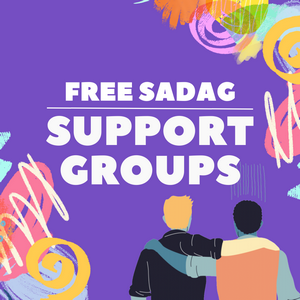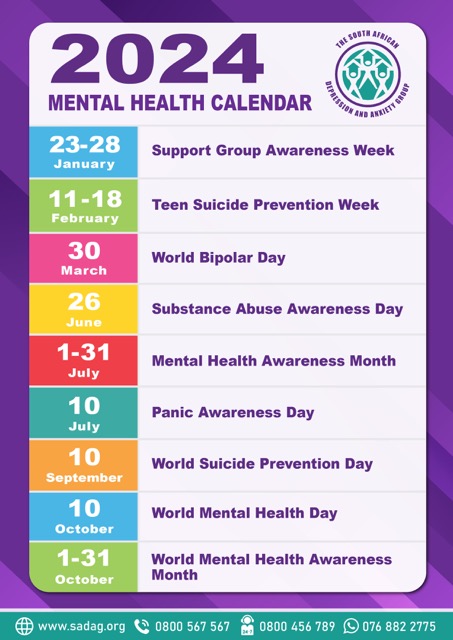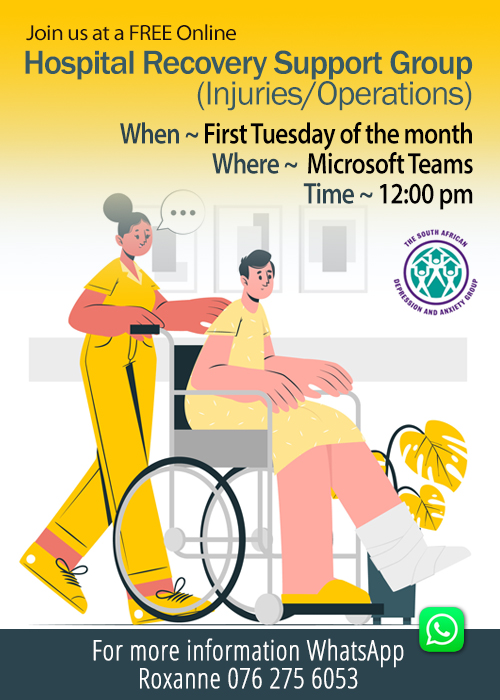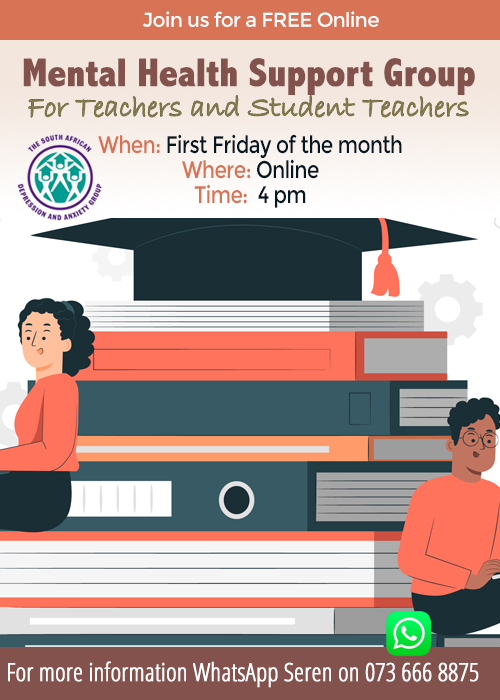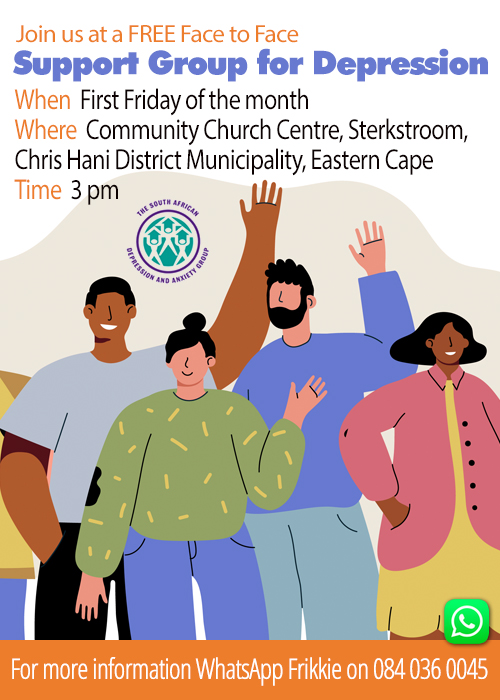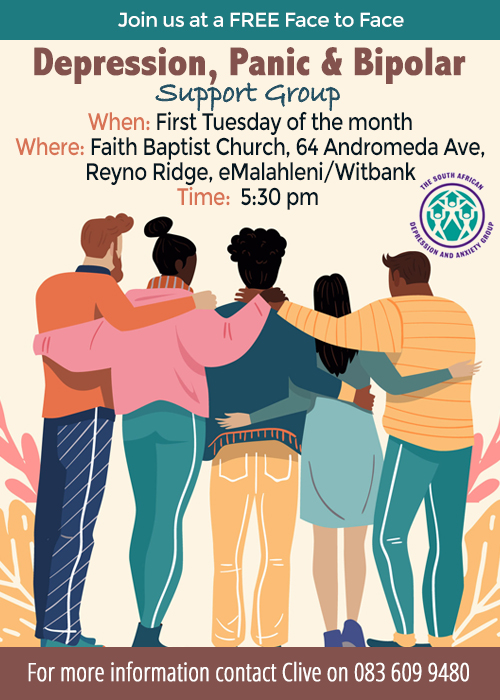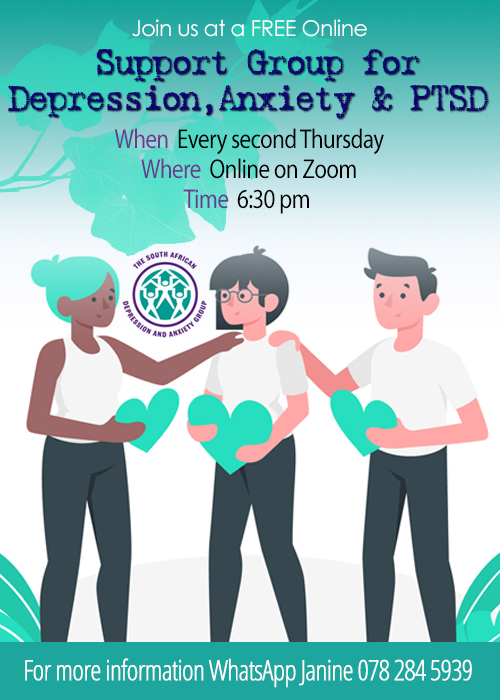Click HERE to find out more
 |
 |
 |
 |
 |
 |
SADAG Support Group Mission Statement
Above all, SADAG Support Group’s aim is to first do no harm.
Support Groups offer aftercare and supplementary support to those who have received professional Mental Health, are managing, and are looking at maintaining or improving their Mental Health.
Support Groups help to fill the gap that many patients experience after having received primary help and support.
A Support Group is a group of people who have similar personal experiences of the same problems or life situations, and are there to help each other feel supported. Support Groups are not there to provide solutions or professional therapy. Rather they offer a non-judgemental safe space where people who have first-hand experience are able to share, listen and support one another.
What can we do to change the stigma associated with Mental Health in SA
What Is A SADAG Support Group?
A Support Group is a gathering of people with common experiences and concerns who meet together to provide emotional and moral support for one another. They encourage a sense of community, a source of empathetic understanding in a judgement-free environment.
Members of Support Groups share their thoughts and feelings and learn from other members’ sharing and life experiences. In a Support Group environment, everyone is seen as an expert of their own life experiences. Rather than a teacher/pupil relationship, where the Support Group Leader is seen as an expert/teacher, and the Support Group Members are seen as pupils, in a Support Group everyone, including the Support Group Leader, plays the role of both the expert and the pupil.
So often in life, when people come to us to share and talk about what they are going through, we are so preoccupied with trying to find a solution that we forget to listen. One of the most valuable gifts we can offer someone is giving them space to share their feelings. We should never underestimate the power of discourse with others who are in the same or similar situations. Sharing experiences enables us to give each other mutual support, normalise our experiences and collect practical information and ways of coping. Group members offer each other emotional and practical support and reduce the sense of isolation that can be associated with Mental Illness and emotional struggles.
A Support Group can help you cope better and feel less alone as you make connections with others facing similar challenges. A Support Group shouldn’t replace your usual medical care but can be a valuable resource to help you cope and manage. As humans, we want to connect with people. Depression can sometimes threaten this, when we feel depressed we feel alone and lonely, we feel that others cannot understand us and we withdraw from people when we need them the most. Fear of stigma and being judged can make us fearful of telling even those we love that we are depressed or suffer from a Mental Illness. Joining a Support Group, or deciding to set one up, is a powerful commitment to form relationships with others again.
Why do you think people are scared or ashamed to speak out about their Mental Health and ask for the help that they need?
Different Types Of Support Groups
SADAG has many different types of Support Groups, each serving different communities and different needs.
There is an endless list of different types of Support Groups, including, but not limited to
- Depression
- Anxiety
- Trauma
- PTSD
- Substance abuse
- Bipolar Disorder
- Post / Peri Natal Depression
- Support Groups for Loved Ones and Family Members of Those with Mental Illness
- Grief and Bereavement
- Post and Perinatal Depression
- Men’s Mental Health
- Chronic Illness
- HIV/AIDS
- Peer / Student Support Groups
- Mental Health in the Workplace
If you are not sure what type of Support Group to join, contact one of our counsellors who will be happy to assist.
The Difference Between Group Therapy And A Support Group
Support Groups and Group Therapy share many common characteristics. They both involve people coming together to share their experiences in a non-judgemental environment. However, the main difference between Group Therapy and a Support Group lies in the fact that Group Therapy is run by a professional who is trained and accredited with the ability to conduct psychotherapy.
Group Therapy can provide primary treatment for a Mental Illness, whereas Support Groups aim to provide supplementary aftercare support.
The majority of SADAG’s Support Group Leaders are patients and ex-patients who have experienced difficulties with their own Mental Health or the Mental Health of a loved one. We do have Support Groups that are run by Mental Health practitioners, however, these practitioners don’t not run their Groups in the capacity of Mental Health practitioners, but rather as Support Group Leaders, where they are as much a Member of the Group as anyone else.
It is not necessary for Support Group Leaders to be Mental Health practitioners, because Support Groups are not therapy, nor are they the first line of mental health treatment/intervention.
Why is a Support Group so important in your community?
What Support Groups Do
Support Groups foster an environment that:
Gives you a voice and helps you to take control:
- A Support Group provides a place of stability and security, a place in which you can feel respected, nurtured and cared for, and above all it provides a “listening place”.
Creates a culture of equality:
- In a Support Group, everyone is equal. It is a place you can go where everyone understands what you are going through and no one judges.
Builds a common identity:
- You will realise by being with others that really understand you, that you are not alone. And what you are experiencing is normal.
- Being with others who are experiencing the same illness or life problem as you and are successfully managing, despite their problems, can be the best encouragement of all.
Is non-judgmental
- There is a code of confidentiality within the Group, each member’s privacy and dignity is respected.
Works against isolation:
- Other members in the Group have first-hand experience of what you are going through
- It’s a wonderful experience to have people rallying behind you and checking in just to see how you’re doing and to say “I’m here if you need me”. It’s equally gratifying to be able to support someone in distress and provide them with comfort.
Allows the sharing of pain:
- Knowing that someone else truly understands by virtue of having “been there”, brings a sense of relief, you are no longer alone with your pain.
- Everyone is given the freedom to draw on the strength of the group as needed and to extend strength to others when possible.
Provides information and referrals:
- When people discuss their “illness”, a great deal of information and education is gained.
- Helps to share coping tips and methods that haven’t only come from books.
How does joining a Support Group help someone who has a Mental Illness?
Who Attends SADAG Support Groups?
Mental Health doesn’t discriminate against race, gender, socio-economic standing, age, or religion, it is something that almost all of us are affected by, be it personally or through a family member or loved one. As such, there are an incredibly diverse group of people who can attend SADAG Support Groups.
Due to the vulnerability and susceptibility of the youth, as well as legal requirements, we advise that only people eighteen and older attend and run Support Groups. Responsible practice, and an emphasis on doing good, not harm, means that we recommend that the youth seek other Mental Health resources where there are a dedicated team that can ensure the safety and well-being of the individual and group.
There are many different types of Support Groups, these offerings extend beyond only the patient, or person living with a Mental Illness. There are Groups dedicated to loved ones and family members, people living with grief, and chronic illness, as well as caregivers to name a few.
How does your Support Group help your members
SUPPORT GROUPS LAUNCHING
|
|
|



